Abstract
OBJECTIVE: To present recent evidence on the use of ovarian hormone therapy (OHT) for osteoporosis and outline safe and effective regimens. OPTIONS: Estrogen alone, estrogen and progestins, progestins alone; various treatment regimens. OUTCOMES: Fracture and loss of bone mineral density in osteoporosis; increased bone mass, prevention of fractures and improved quality of life associated with OHT. EVIDENCE: Relevant clinical studies and reports, including the Nurses' Health Study and the Post-menopausal Estrogen/Progestin Interventions (PEPI) Trial, were studied with emphasis on recent prospective, randomized, controlled trials. Current clinical practice was determined by survey. VALUES: Reducing fractures, increasing bone mineral density and minimizing side effects of treatment were given a high value. BENEFITS, HARMS AND COSTS: Proper management of osteoporosis minimizes injury and disability, improves quality of life and reduces the personal and social costs associated with the condition. OHT is the front-line pharmaceutical therapy for prevention and treatment of osteoporosis in post-menopausal women. In those who are able and willing to comply with therapy, OHT prevents bone loss and fractures. Hormone therapy may also decrease risk of coronary artery disease. Cyclic progestin protects against endometrial cancer in patients receiving estrogen. Potential harms include breast cancer and endometrial cancer related to dosage and duration of therapy. Mastalgia and especially resumption of menstrual bleeding affect compliance. RECOMMENDATIONS: Use of OHT should be considered as early as possible in the perimenopausal period for women at increased risk of osteoporosis. Guidelines are provided for assessment of osteoporosis risk. Physicians and their patients should take into account the absolute and relative contraindications to OHT. Women with a uterus should be given estrogen in combination with a progestin. Ideally, therapy would be continued for a minimum of 10 years beyond menopause for maximum bone protection. Women using OHT should be carefully monitored and evaluated for possible adverse events. This should include regular screening mammography, breast examination and, for some, endometrial surveillance. Specific dosages and treatment regimens are outlined.
Full text
PDF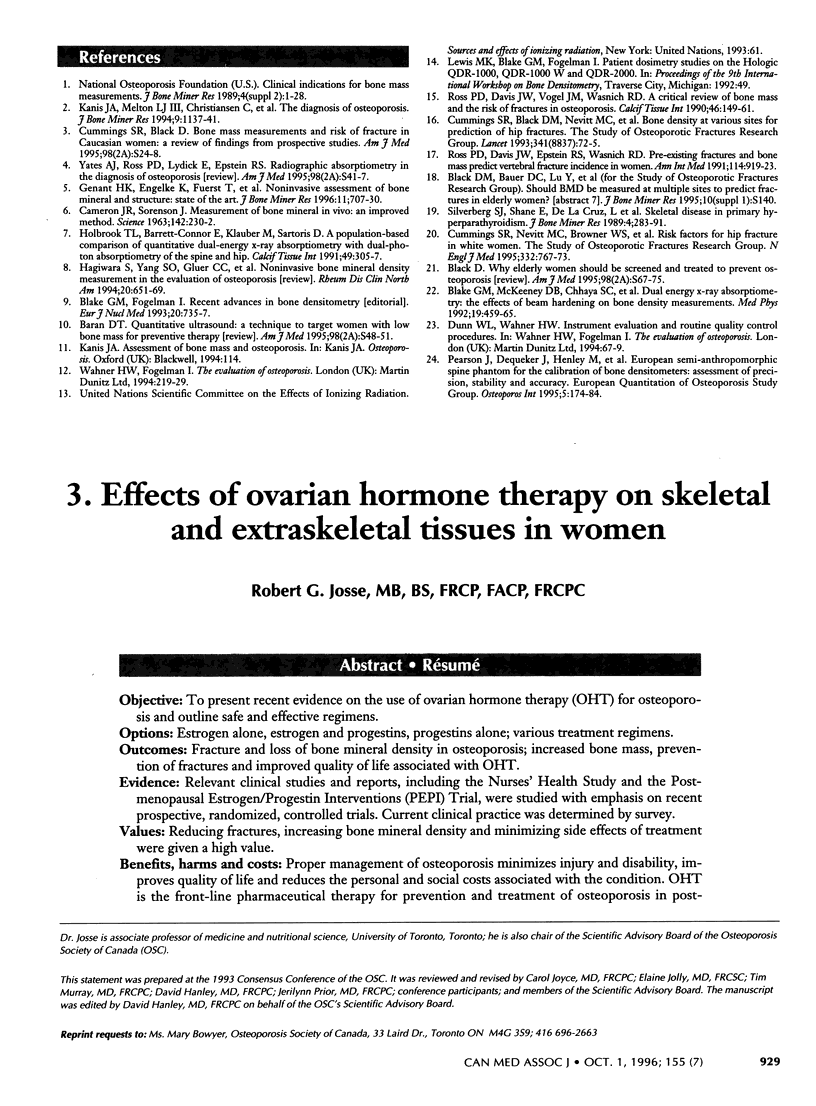
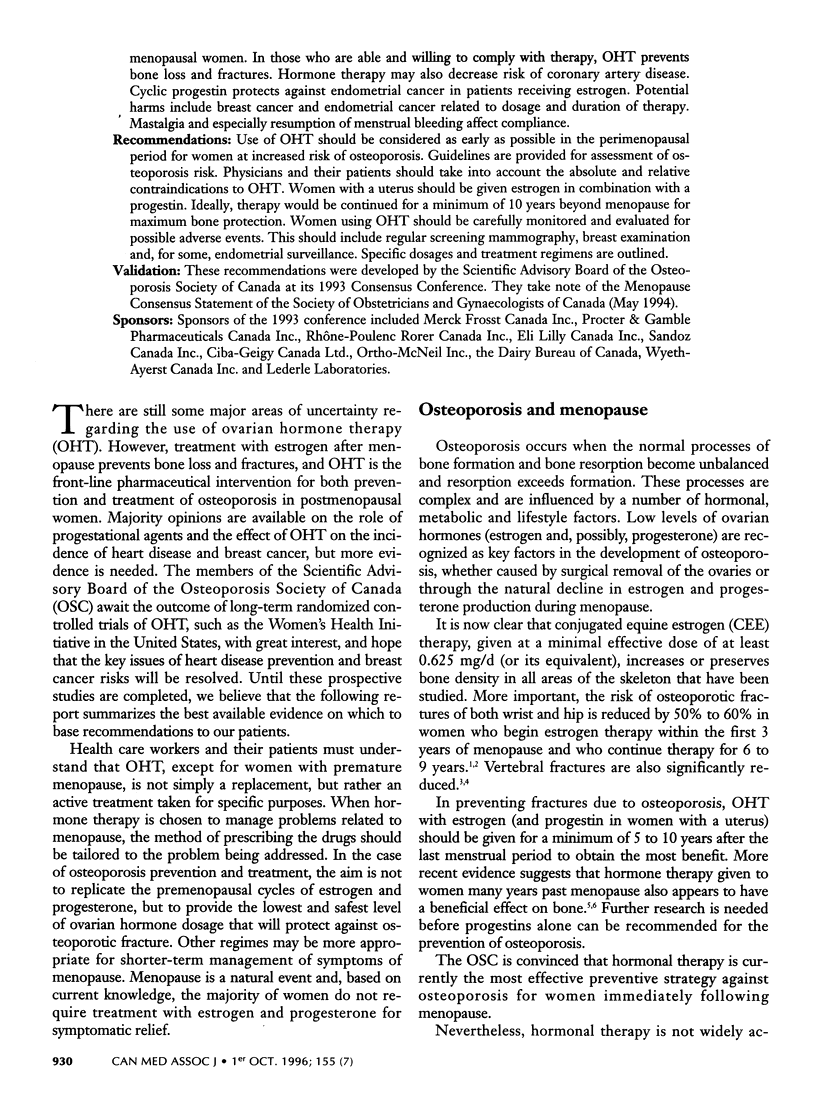
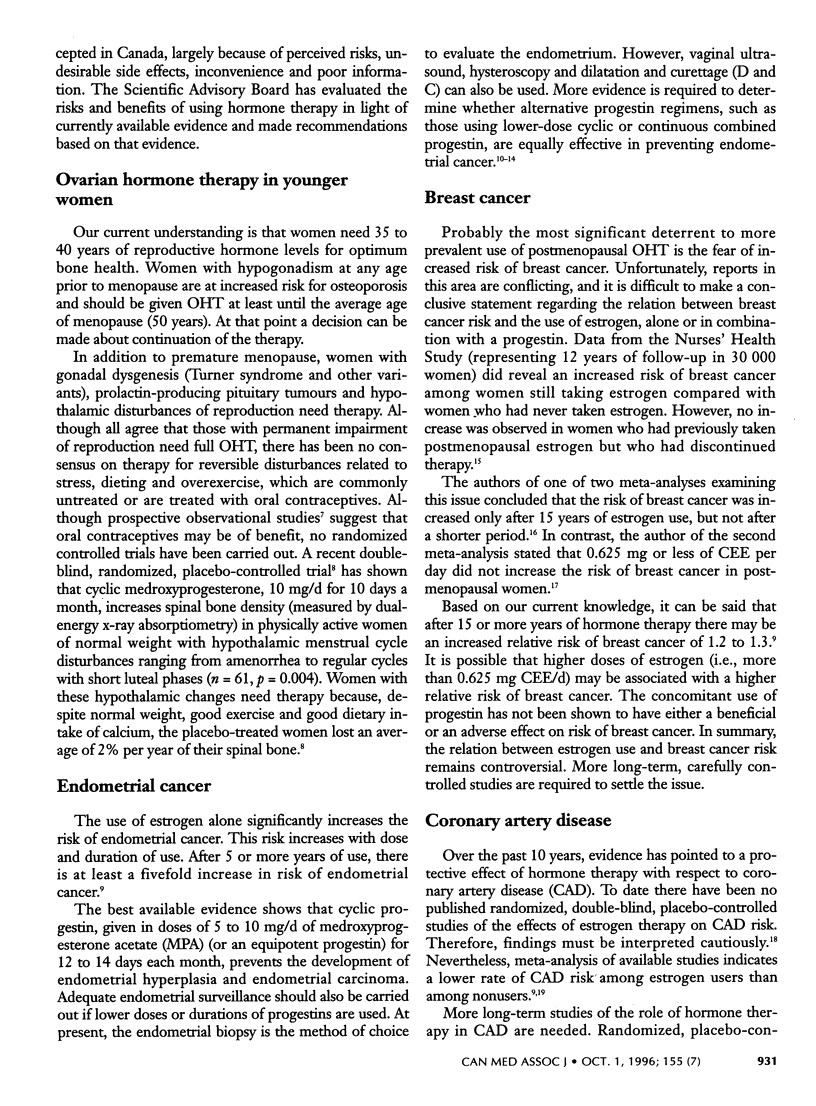
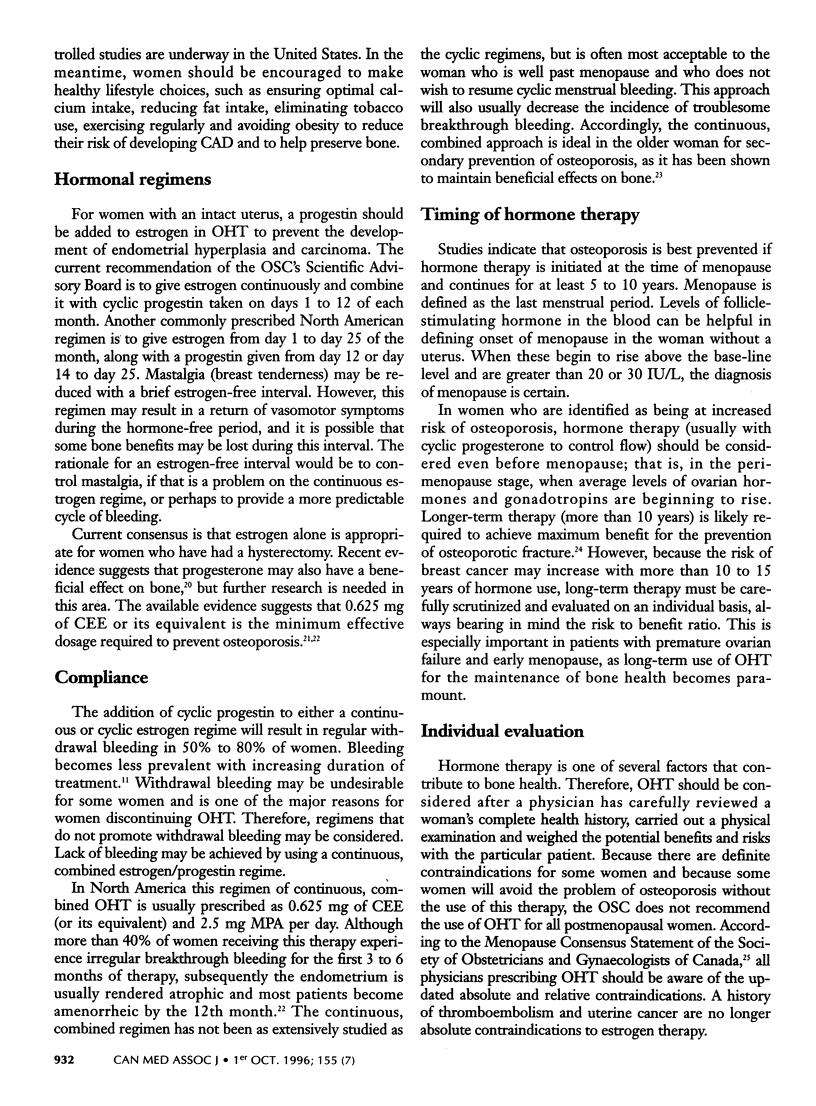
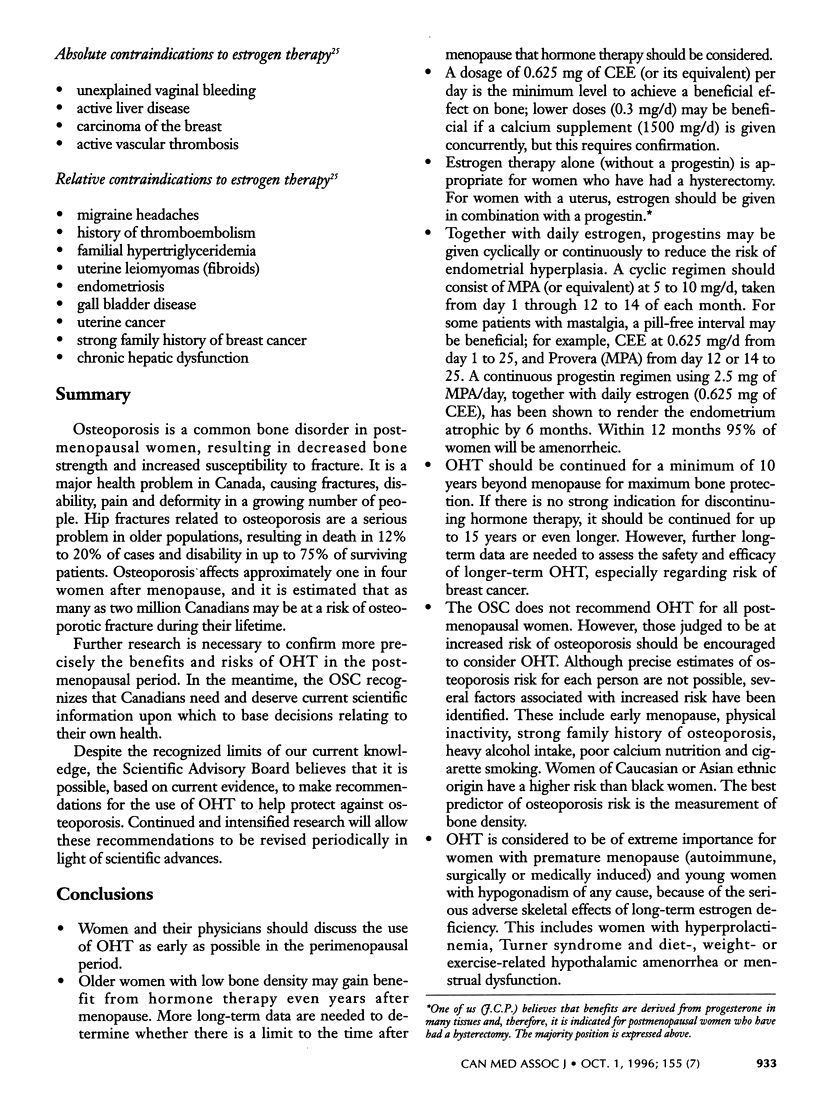
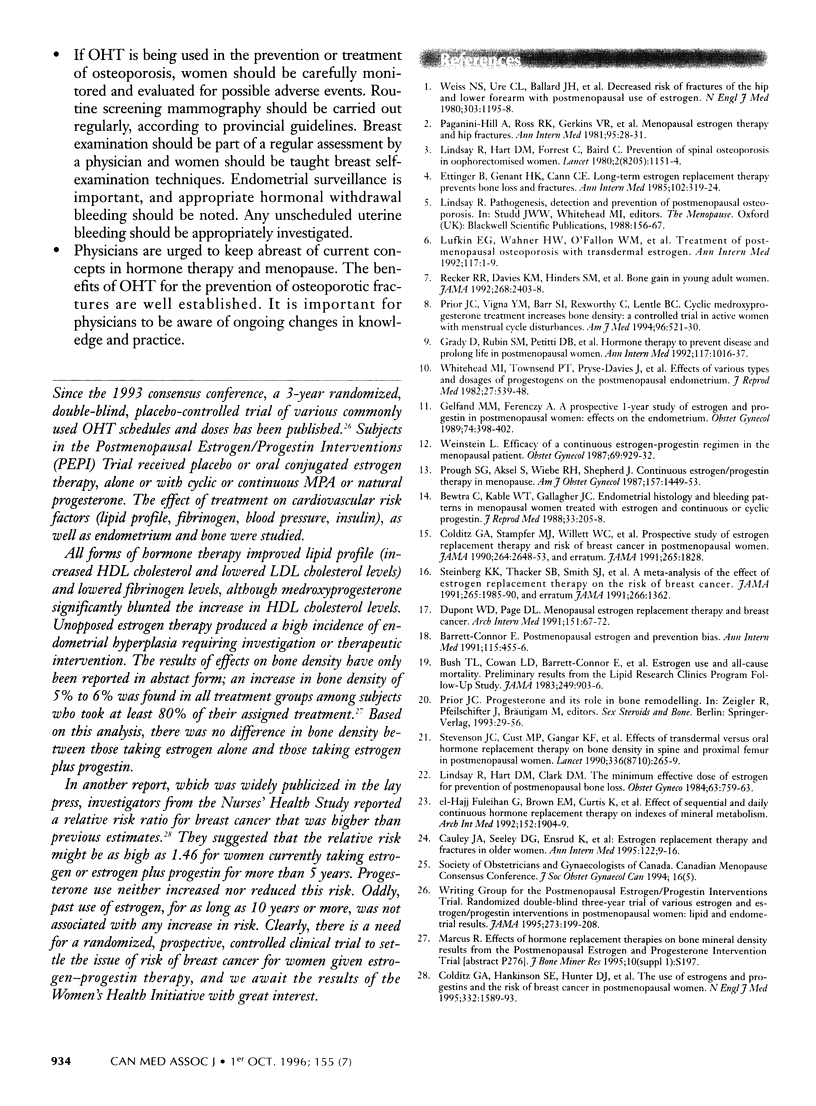
Selected References
These references are in PubMed. This may not be the complete list of references from this article.
- Barrett-Connor E. Postmenopausal estrogen and prevention bias. Ann Intern Med. 1991 Sep 15;115(6):455–456. doi: 10.7326/0003-4819-115-6-455. [DOI] [PubMed] [Google Scholar]
- Bewtra C., Kable W. T., Gallagher J. C. Endometrial histology and bleeding patterns in menopausal women treated with estrogen and continuous or cyclic progestin. J Reprod Med. 1988 Feb;33(2):205–208. [PubMed] [Google Scholar]
- Bush T. L., Cowan L. D., Barrett-Connor E., Criqui M. H., Karon J. M., Wallace R. B., Tyroler H. A., Rifkind B. M. Estrogen use and all-cause mortality. Preliminary results from the Lipid Research Clinics Program Follow-Up Study. JAMA. 1983 Feb 18;249(7):903–906. doi: 10.1001/jama.249.7.903. [DOI] [PubMed] [Google Scholar]
- Cauley J. A., Seeley D. G., Ensrud K., Ettinger B., Black D., Cummings S. R. Estrogen replacement therapy and fractures in older women. Study of Osteoporotic Fractures Research Group. Ann Intern Med. 1995 Jan 1;122(1):9–16. doi: 10.7326/0003-4819-122-1-199501010-00002. [DOI] [PubMed] [Google Scholar]
- Colditz G. A., Hankinson S. E., Hunter D. J., Willett W. C., Manson J. E., Stampfer M. J., Hennekens C., Rosner B., Speizer F. E. The use of estrogens and progestins and the risk of breast cancer in postmenopausal women. N Engl J Med. 1995 Jun 15;332(24):1589–1593. doi: 10.1056/NEJM199506153322401. [DOI] [PubMed] [Google Scholar]
- Colditz G. A., Stampfer M. J., Willett W. C., Hennekens C. H., Rosner B., Speizer F. E. Prospective study of estrogen replacement therapy and risk of breast cancer in postmenopausal women. JAMA. 1990 Nov 28;264(20):2648–2653. [PubMed] [Google Scholar]
- Dupont W. D., Page D. L. Menopausal estrogen replacement therapy and breast cancer. Arch Intern Med. 1991 Jan;151(1):67–72. [PubMed] [Google Scholar]
- Gelfand M. M., Ferenczy A. A prospective 1-year study of estrogen and progestin in postmenopausal women: effects on the endometrium. Obstet Gynecol. 1989 Sep;74(3 Pt 1):398–402. [PubMed] [Google Scholar]
- Grady D., Rubin S. M., Petitti D. B., Fox C. S., Black D., Ettinger B., Ernster V. L., Cummings S. R. Hormone therapy to prevent disease and prolong life in postmenopausal women. Ann Intern Med. 1992 Dec 15;117(12):1016–1037. doi: 10.7326/0003-4819-117-12-1016. [DOI] [PubMed] [Google Scholar]
- Lindsay R., Hart D. M., Clark D. M. The minimum effective dose of estrogen for prevention of postmenopausal bone loss. Obstet Gynecol. 1984 Jun;63(6):759–763. [PubMed] [Google Scholar]
- Paganini-Hill A., Ross R. K., Gerkins V. R., Henderson B. E., Arthur M., Mack T. M. Menopausal estrogen therapy and hip fractures. Ann Intern Med. 1981 Jul;95(1):28–31. doi: 10.7326/0003-4819-95-1-28. [DOI] [PubMed] [Google Scholar]
- Prior J. C., Vigna Y. M., Barr S. I., Rexworthy C., Lentle B. C. Cyclic medroxyprogesterone treatment increases bone density: a controlled trial in active women with menstrual cycle disturbances. Am J Med. 1994 Jun;96(6):521–530. doi: 10.1016/0002-9343(94)90092-2. [DOI] [PubMed] [Google Scholar]
- Prough S. G., Aksel S., Wiebe R. H., Shepherd J. Continuous estrogen/progestin therapy in menopause. Am J Obstet Gynecol. 1987 Dec;157(6):1449–1453. doi: 10.1016/s0002-9378(87)80242-9. [DOI] [PubMed] [Google Scholar]
- Recker R. R., Davies K. M., Hinders S. M., Heaney R. P., Stegman M. R., Kimmel D. B. Bone gain in young adult women. JAMA. 1992 Nov 4;268(17):2403–2408. [PubMed] [Google Scholar]
- Steinberg K. K., Thacker S. B., Smith S. J., Stroup D. F., Zack M. M., Flanders W. D., Berkelman R. L. A meta-analysis of the effect of estrogen replacement therapy on the risk of breast cancer. JAMA. 1991 Apr 17;265(15):1985–1990. [PubMed] [Google Scholar]
- Stevenson J. C., Cust M. P., Gangar K. F., Hillard T. C., Lees B., Whitehead M. I. Effects of transdermal versus oral hormone replacement therapy on bone density in spine and proximal femur in postmenopausal women. Lancet. 1990 Aug 4;336(8710):265–269. doi: 10.1016/0140-6736(90)91801-g. [DOI] [PubMed] [Google Scholar]
- Weinstein L. Efficacy of a continuous estrogen-progestin regimen in the menopausal patient. Obstet Gynecol. 1987 Jun;69(6):929–932. [PubMed] [Google Scholar]
- Whitehead M. I., Townsend P. T., Pryse-Davies J., Ryder T., Lane G., Siddle N. C., King R. J. Effects of various types and dosages of progestogens on the postmenopausal endometrium. J Reprod Med. 1982 Aug;27(8 Suppl):539–548. [PubMed] [Google Scholar]
- el-Hajj Fuleihan G., Brown E. M., Curtis K., Berger M. J., Berger B. M., Gleason R., LeBoff M. S. Effect of sequential and daily continuous hormone replacement therapy on indexes of mineral metabolism. Arch Intern Med. 1992 Sep;152(9):1904–1909. doi: 10.1001/archinte.152.9.1904. [DOI] [PubMed] [Google Scholar]


